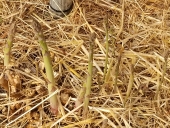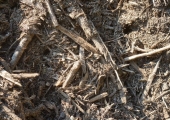Most people on permies.com have much longer growing seasons than I do. So I am often tardy because of that, and sometimes I go beyond that.
Lots of places have written that buckwheat can be planted "late" and still outgrow weeds. Last year, the tallest any of my buckwheat got was 6 inches. Coming up to end of July (planting a bit earlier), I've got some buckwheat at 2 inches. I had some buckwheat germinate in wood chips, but it took a while. Sorrel doesn't seem to want to germinate in wood chips, or in a thin layer of
compost on top of wood chips. I have a large raised bed I cannot reach across (it is 15x24), and so to reach some places in the centre, I tossed some sunflower seeds (the corn had died in the wind, and it was my first 3 sisters attempt). I have sunflower germinating all over the raised bed, even "upwind" of where I through them. So, it doesn't appear you actually need to "plant" sunflower seeds. I suspect birds are moving the seeds upwind? Can't be bambi.
In the spirit of the Eden garden, on some old fescue pasture (a place heavy in quack grass), last summer I covered (uncut pasture) from about now to end of season in black plastic (actually, plastic not removed to this spring). This spring I put about 3 inches of wood chips on top of the (not quite dead pasture), and then I built a raised bed from aspen logs I split in half. Within the raised bed, I spread a layer of "soil" that probably was between 0.5 and 1 inch deep. Into this "soil", I placed pieces of seed potato. And then I covered this with 5 inches of wood chips. The location of this raised bed is about as "wet" as any place on the farm (being on the eastern slopes of the Rockies, we average 19 inches of precip per year). I've got lots of little (tallest maybe 7 inches) "potato trees" all over this raised bed. But none of these plants look like potato plants I've seen when people planted in dirt. It will be interesting to see what happens.
Because my growing season is short at best, I had started the corn (Stowells Evergreen) and sunflowers (various) in pots. At best, I did not harden off these plants well enough, before planting them. The sunflowers were all too floppy, and the corn plants couldn't handle the wind (of 76 corn plants, I might have 6 still growing, biggest about 6 leaf stage). I planted squash around the corn plot, and zucchini around the sunflower plots. Some of the squash seeds had been given a warm water soak, and few if any of those germinated.
Which leads me into tree seeds. I had bought a reasonably large (2litre?) ultrasound unit, probably meant for a dental office? It can irradiate things with ultrasound for varying lengths of times, which mostly tend to be multiples of 3 minutes. It does have a heater for the bath, and it will heat water to whatever temperature you like, as long as it is 65C. So the warm water soak the squash seeds got, was at 65C.
I am not close to being finished planting out seeds (I am tardy), I am over 10%. All these seeds in question, have spent the last N months damp, in the fridge. Among the seeds, are a birch hybrid and gray alder (also in the birch family). These are tiny seeds, and hard to work with in bags. And the paper towel I often wrapped the seeds in, had about the strength of toilet paper after this time, so even seeds that were larger than birch seeds, often could not be differentiated from the paper, or from soil in the bag meant to buffer moisture. If the seeds were just in paper towel, I would put some moist soil in a mixing container, add some dry soil, and then add the seeds I managed to collect from the bag and off the paper towel.. I then mixed the seeds with the slightly dried (from mixing dry soil with moist soil) soil, and then I would spread this on an area of moist soil in a "tray", and sort of mix it in and sort of level it. This soil is VERY fluffy.
If the bag of seeds had a soil buffer in it, I would put the soil buffer in the mixing container, tear up the paper towel and attached soil into small pieces, add that to the buffer soil, mix it, add dry soil, and mix some more. And then spread that onto moist soil in a tray, mix it with the surface soil and level it (sort of). Again fluffy.
In handling slightly larger seeds (maybe the size of seeds in a chili), I sometimes found that to touch the seed was to smear it to nothing. No apparent sign of mold, so I am guessing the plant had rotted with no soil present.
The largest seeds I put to stratification/scarification, were from Kentucky Coffee Tree. Probably the warmest zone seeds I had prepared, and really I don't think they would either live here, or would be useful here. My Mom likes coffee, and maybe I could make her a special coffee in 20 years or so.

Big seeds. First step was to soak them in warm (my usound bath is 65C) water. Some seeds swole up. Soak the ones that didn't again. Again some swole up. This soaking often cracked the seed coat, and in a couple of occasions the hard seed coat just fell of the "kernel".
The ones that swole up and the ones that didn't, were both put in the fridge for months. The ones that had swole up, continued to swell while in the fridge. As a first approximation, the swole into a continuous mass in the bottom of my container (which had soil, because the seeds were so large). To me, it looks like there was some "white mold" almost everywhere. I suspect none of those seeds are viable, but they are so much bigger than anything I've worked with. I did plant some unswollen seeds and the best of the swolen ones into soil, and I'll see what happens germination wise.
Russian hawthorn seeds much bigger than English hawthorn seeds. Manchurian vibernum seeds were too small. Elderberry seeds were too small. Blue and white false indigo seeds were too small.
---
With so many tree seeds being so small, how is someone with big fingers supposed to work with these things? I know when I first seen paper tape for things like onion seeds, I thought that was a wonderful idea.
---
Yet to come in my seed planting, is two kinds of pine seeds (both large, edible nuts), a bunch of osage-orange and a bunch of honey locust. The pine seeds are either Korean or Swiss stone. As I understand both of these pines need to be germinated and grown in shade for 2 years (possibly longer). They sunburn easily. I have 5 or 6 rows of evergreens growing next to the house, so I was going to put the pine seeds there to spends most of their early life shaded. I have more Swiss stone pine seeds left, and I was going to just pot up some and put them out as well. As I understand, they could take a winter or two to get to the germination stage.
---
This is the end of July. August usually becomes very dry. A killing frost (for vegetables) could be just about anytime from the end of August, but mid-September on is more likely. Halloween usually sees snow. And freeze up in October is typical.
My soil is mostly clay.
As i understand things, I can overwinter seedlings. Most people would overwinter by digging a trench, setting the trays in the trench, and then "sort of" filling with sand? I had thought about insulating with styrofoam insulation, but I have so many mule deer and especially moose walking through my yard in the winter, if I put down foam insulation that would mean putting plywood on top of that to keep the deer from breaking through when they walk on it.
I could order a dump truck full of sand. That would probably be enough to "bury" the seedlings in sand. And I could use the sand in the future (not that I want to get into tilling stuff into the soil).
Hopefully you don't get as tardy as I have.

As Spock was heard to say on some unknown Star Trek episode: "May all your deer problems, be 'small deer' problems (like whtetail deer)".

 1
1




 Big seeds. First step was to soak them in warm (my usound bath is 65C) water. Some seeds swole up. Soak the ones that didn't again. Again some swole up. This soaking often cracked the seed coat, and in a couple of occasions the hard seed coat just fell of the "kernel".
Big seeds. First step was to soak them in warm (my usound bath is 65C) water. Some seeds swole up. Soak the ones that didn't again. Again some swole up. This soaking often cracked the seed coat, and in a couple of occasions the hard seed coat just fell of the "kernel".






 1
1




 1
1









































